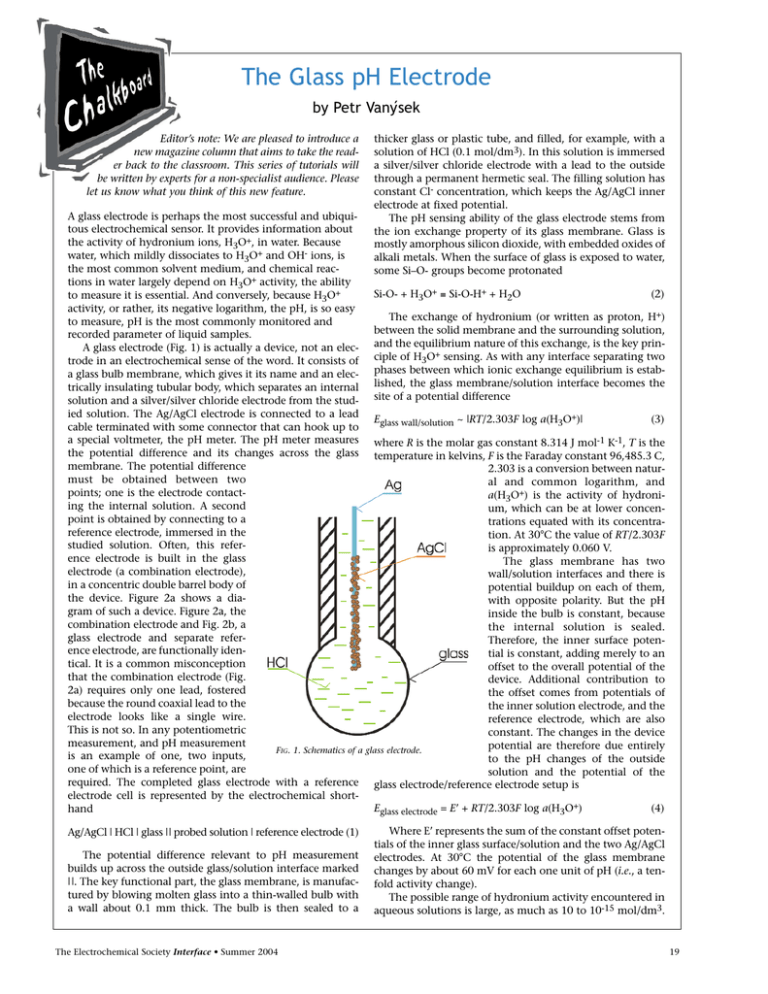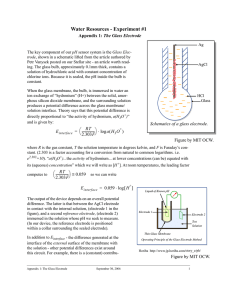The Glass pH Electrode - The Electrochemical Society
advertisement

The Glass pH Electrode by Petr Vanýsek Editor’s note: We are pleased to introduce a new magazine column that aims to take the reader back to the classroom. This series of tutorials will be written by experts for a non-specialist audience. Please let us know what you think of this new feature. thicker glass or plastic tube, and filled, for example, with a solution of HCl (0.1 mol/dm3). In this solution is immersed a silver/silver chloride electrode with a lead to the outside through a permanent hermetic seal. The filling solution has constant Cl- concentration, which keeps the Ag/AgCl inner electrode at fixed potential. The pH sensing ability of the glass electrode stems from the ion exchange property of its glass membrane. Glass is mostly amorphous silicon dioxide, with embedded oxides of alkali metals. When the surface of glass is exposed to water, some Si–O- groups become protonated A glass electrode is perhaps the most successful and ubiquitous electrochemical sensor. It provides information about the activity of hydronium ions, H3O+, in water. Because water, which mildly dissociates to H3O+ and OH- ions, is the most common solvent medium, and chemical reactions in water largely depend on H3O+ activity, the ability (2) Si-O- + H3O+ ≡ Si-O-H+ + H2O to measure it is essential. And conversely, because H3O+ activity, or rather, its negative logarithm, the pH, is so easy The exchange of hydronium (or written as proton, H+) to measure, pH is the most commonly monitored and between the solid membrane and the surrounding solution, recorded parameter of liquid samples. and the equilibrium nature of this exchange, is the key prinA glass electrode (Fig. 1) is actually a device, not an elec+ trode in an electrochemical sense of the word. It consists of ciple of H3O sensing. As with any interface separating two a glass bulb membrane, which gives it its name and an elec- phases between which ionic exchange equilibrium is estabtrically insulating tubular body, which separates an internal lished, the glass membrane/solution interface becomes the solution and a silver/silver chloride electrode from the stud- site of a potential difference ied solution. The Ag/AgCl electrode is connected to a lead (3) Eglass wall/solution ~ |RT/2.303F log a(H3O+)| cable terminated with some connector that can hook up to a special voltmeter, the pH meter. The pH meter measures where R is the molar gas constant 8.314 J mol-1 K-1, T is the the potential difference and its changes across the glass temperature in kelvins, F is the Faraday constant 96,485.3 C, membrane. The potential difference 2.303 is a conversion between naturmust be obtained between two al and common logarithm, and points; one is the electrode contacta(H3O+) is the activity of hydroniing the internal solution. A second um, which can be at lower concenpoint is obtained by connecting to a trations equated with its concentrareference electrode, immersed in the tion. At 30°C the value of RT/2.303F studied solution. Often, this referis approximately 0.060 V. ence electrode is built in the glass The glass membrane has two electrode (a combination electrode), wall/solution interfaces and there is in a concentric double barrel body of potential buildup on each of them, the device. Figure 2a shows a diawith opposite polarity. But the pH gram of such a device. Figure 2a, the inside the bulb is constant, because combination electrode and Fig. 2b, a the internal solution is sealed. glass electrode and separate referTherefore, the inner surface potenence electrode, are functionally idential is constant, adding merely to an tical. It is a common misconception offset to the overall potential of the that the combination electrode (Fig. device. Additional contribution to 2a) requires only one lead, fostered the offset comes from potentials of because the round coaxial lead to the the inner solution electrode, and the electrode looks like a single wire. reference electrode, which are also This is not so. In any potentiometric constant. The changes in the device measurement, and pH measurement potential are therefore due entirely FIG. 1. Schematics of a glass electrode. is an example of one, two inputs, to the pH changes of the outside one of which is a reference point, are solution and the potential of the required. The completed glass electrode with a reference glass electrode/reference electrode setup is electrode cell is represented by the electrochemical short(4) Eglass electrode = E’ + RT/2.303F log a(H3O+) hand Ag/AgCl | HCl | glass || probed solution | reference electrode (1) The potential difference relevant to pH measurement builds up across the outside glass/solution interface marked ||. The key functional part, the glass membrane, is manufactured by blowing molten glass into a thin-walled bulb with a wall about 0.1 mm thick. The bulb is then sealed to a The Electrochemical Society Interface • Summer 2004 Where E’ represents the sum of the constant offset potentials of the inner glass surface/solution and the two Ag/AgCl electrodes. At 30°C the potential of the glass membrane changes by about 60 mV for each one unit of pH (i.e., a tenfold activity change). The possible range of hydronium activity encountered in aqueous solutions is large, as much as 10 to 10-15 mol/dm3. 19 To encompass such a wide dynamic range, a logarithmic scale was established, defining the pH of a solution as The lore of proper glass electrode handling is rich and often irrelevant. The glass of the membrane has evolved, the pH meters are more reliable, and the electrodes have become more (5) pH = - log a(H3O+) affordable. The glass membrane of the past must have remained wet for proper hydration. That is not true for the The negative sign assures that pH of most solutions, except modern type and it is recommended that, if not used for severextremely acidic ones, is always positive. It is fortuitous that the al days, the electrodes are allowed to dry. They should be rinsed potential of the glass electrode (Eq. 4) is also a logarithmic func- thoroughly, though, because a drying crust of solids would tion of hydronium activity; therefore, the potential of the glass crack and destroy the membrane. Prior to initial use a glass electrode is a linear function of pH electrode must be soaked in water to regenerate the hydrated layer. But the elaborate procedure for early electrodes has (6) Eglass electrode = E’ – RT/2.303F pH changed to a short wait for the modern counterparts. There are The Eglass electrode is measured with a pH meter, a voltmeter also recipes describing how to bring an ill-performing electrode with circuitry allowing direct readout of pH. The meter sub- back to life. Described are such heroic procedures as a quick dip in hydrofluoric acid. It is hardly worth tracts the potential offset E’. Although it the effort though, because some modern could be calculated, it is more practical devices come with a replaceable, if not to calibrate the glass electrode using disposable, glass membrane tip. The buffers. For example, if two buffers are replacement cost is often less than used in sequence, one at pH 7 and would be the wage paid to someone tryanother at pH 4, it is also possible to caling to rejuvenate a flawed electrode. ibrate the actual slope of Eq. 6. Although However, these practical recipes remain it is mathematically given (RT/2.303F), great lessons in chemistry and materials the behavior in the presence of interferscience. ing ions or with deteriorating glass elecThe glass electrode has been around trode is not always that ideal. The coralmost a century. In 1906 Max Cremer1 rection for temperature (T) is also made during his studies of liquid interfaces in a two-buffer calculation. Increasingly, blew in a flame a thin bubble at the end glass electrodes and hand held pH detecof a glass tube and measured the potentors, have built-in temperature probes, tial difference between one liquid inside linked to an automated electronic temand a different one on the outside. Fritz perature correction. Because the pH of Haber (Nobel Prize winner for the synstandard buffers is available to two deciFIG. 2. Measurement with (left) a glass electrode, thesis of ammonia) and Zygmunt mal places, measured pH should be combination style; and (right) a separate glass Klemensiewicz2 measured in a series of reported to no more than two decimal electrode and a reference electrode. experiments the potential difference on places, despite that most pH meters can two sides of a glass membrane; they disdisplay three places or more. Practical covered that the potential is a function reproducibility is about ± 0.05 units. The circuit across which the pH meter measures the poten- of proton activity and coined the name glass electrode. tial difference has high electric resistance. Even though the resistance is minimized by blowing the glass very thin and doping it with a mix of alkali metals, the circuit resistance is still 107-109 Ω, which is too high for a normal voltmeter; a special kind with high input impedance is needed. The ubiquity of glass electrode pH sensors was made possible through advances in electronics. The first significant step was introduction of a high input impedance vacuum tube amplifier in 1928; however, a key to miniaturization and low cost came through introduction of field-effect transistors and subsequently the knowledge to integrate them with the digital signal processing circuitry on a single chip. Modern pH meters, combining the glass membrane sensing element, electronics, and a display, are now the size of a pen, no larger than a glass electrode of only a few years ago. Still, the glass electrodes of today share with the glass electrodes of yesterday both their working principle and their limitations. A common interference with sensing hydronium comes from ions of similar size, notably the alkali metals. The interference is somewhat alleviated by using specialty lithium glass, with sites too small to fit Na+ or K+. Alkali metal interference is not the only complication. In solutions of concentrated alkali hydroxides not only the metal ion concentration is high, the activity of H3O+ is small, making equilibration more complicated. And on top of that, strong alkaline solutions etch and possibly permanently damage glass surfaces. Fluoride is another ion that can physically damage glass. Additionally, solutions with proteins, that adsorb on surface, or solutions of ions of more noble metals (Ag, Cu) that could reduce and deposit on the glass surface, should also be avoided. 20 References 1. 2. M. Cremer, Z. Biol., 47, 562 (1906). F. Haber and Z. Klemensiewicz, Z. Physik. Chem., 67, 385(1909). About the Author PETR VANY’SEK was born and educated in Czechoslovakia, where he received his PhD in physical chemistry while working on electrochemistry of liquid/liquid interfaces. His academic experience includes postdoctoral work at the University of North Carolina, a year as a faculty-in-residence at the University of New Hampshire, and two sabbaticals; at The University of Calgary and at Aclara BioSciences, where he spent an additional year on a leave of absence. He has been a regular faculty member at the Department of Chemistry and Biochemistry at Northern Illinois University since 1985. Dr. Vanýsek’s research interests are in physical and electroanalytical aspects of interfaces between immiscible solutions (which coincidentally dates back to the invention of the glass electrode), studies of corrosion and development of sensors, microfluidics, and fuel cells. He is focused on detailed understanding of interpretation of impedance. Through his teaching assignments he has became an expert in many aspects of analytical measurements, including those of proper use of pH instrumentation. Dr. Vanýsek has been a member of The Electrochemical Society since 1986 and presently serves as its secretary. The Electrochemical Society Interface • Summer 2004



